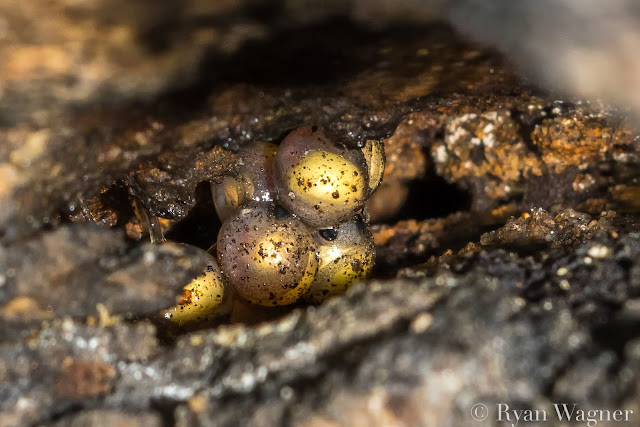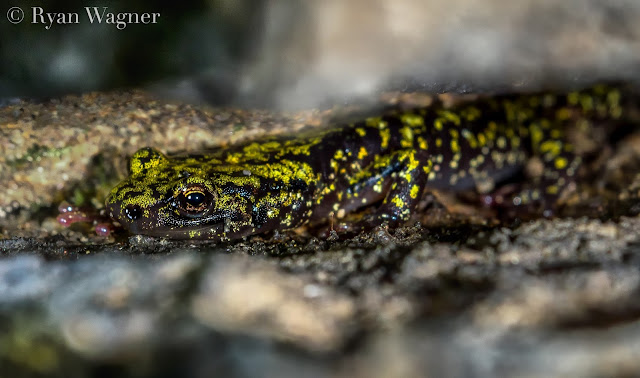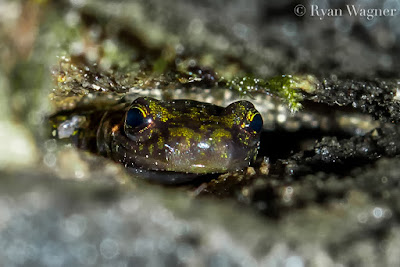I scanned my headlamp across the glittering surface of an enormous wall of lichen-covered sandstone. I felt like a contortionist as I twisted my head in order to peer into every crack and dimple in the stone's face. Eventually, I reached a long crevice that separated two of the immense rocky outcroppings. The crevice was little more than an inch wide, and grew progressively tighter the farther back I looked. My small headlamp illuminated different degrees of rock as I moved along, casting the surroundings into deep shadow. All of a sudden, my light fell on the elongate body of an amphibian. The salamander was small, only a few inches in length. Its skin was covered in little, splotchy markings—but were they green markings? I quickly turned off my light, not wanting to scare the creature away before I could be positive what it was.
 |
| A northern slimy salamander. |
Carl and I had traveled down to southeastern Ohio to search for the state-endangered green salamander. “Each of these ridges with exposed rock should have them,” Carl explained, pointing out hotspots on his topographic map. He had searched this location in past years with a 100% success rate. I had looked for green salamanders once before with no luck. Read about my adventure in The Henslow’s Sparrow and the Search for the Green Salamander. This time, I felt good about our odds.
Green salamanders are a curious species. They occur in Ohio at the extreme northern tip of their range, only extending into a few southern most counties. They inhabit the crevices of limestone and sandstone cliffs in forested areas. Often wedged deep within the rock’s pockmarked visage, the salamanders take some ingenuity to find.
I led Carl back to the fissure where I had discovered the little, freckled salamander moments earlier. He took one look with his flashlight and confirmed, “That’s exactly what we are looking for! A green salamander!” We sat hunched over for the next 20 minutes, angling our cameras so the flash would hit the salamander just right. Photographing in such tight quarters is no easy task. The salamander was small for a green. At only a few inches in length, it was likely a hatchling from the previous year.
To finally have a green salamander at hand was a relief. Ever since my efforts had been thwarted a few months prior, I had been counting down the days until I could hunt for them again. On this search, I was determined to check every stretch of rock, even if it took all day. Finding our green turned out to be much easier than I had anticipated. This was only the second series of rocks we had checked, and I found the little salamander just minutes into our search. It sat parallel to the vertical rock wall, calmly ignoring my light. Some green salamanders grow nervous when illuminated, retreating deeper into the rock. Its body was purple-ish black with yellow-green markings similar to the lichens that cover its abode. It would have been easy to overlook.
As we hiked on, we continued to scan each large stretch of rock for salamanders. “The tiny cracks that reach deep into the stone are good places to check,” Carl explained. Salamanders (and most herps for that matter) tend to hide in spaces just big enough for their own bodies to fit. This keeps them hidden and prevents larger predators from entering. At most of the holes I examined, I was met with the bizarre, curled body of a large species of cave cricket. Below overhangs of stone, where sandy soil had been deposited, we found the funnel traps of ant lions (small larval insects that dig pits to trap prey). As we came to one rounded slab of stone, we hit pay dirt. Along a section that stretched several meters, we found four more small green salamanders!
 |
| Green Salamander Habitat. |
As we photographed and marveled at our luck, Carl made another fascinating discovery. Hanging from the ceiling of one rock crevice were several green salamander eggs! Green salamander mothers will remain with their clutch until they hatch. The mother was likely hidden behind the egg mass, out of our line of sight. Green eggs usually hatch by September, so finding a clutch was a real surprise. Green salamanders skip the tadpole stage (direct development) and emerge from eggs as miniature adults. The hatchlings may remain with their mother for a few weeks and reach sexual maturity by year three.
 |
| Green salamander eggs. |
We had found our target species for the day: the rare and beautiful green salamander. I couldn't have been happier. Across their limited Ohio range, green salamanders likely occur in most areas with suitable sandstone cliffs. Much of their habitat is hidden away on private lands, limiting the number of populations herpetologists can discover. The rough, rocky terrain that suits these amphibians will hopefully protect their homes from being demolished or developed.
As we were preparing to head home, Carl decided to drive the final stretch of road we were parked along. The day was warm and cloudy—perfect for reptile movement. The paved road was a light, uniform gray. Anything on it would jump out like a sore thumb. As we crept along, the asphalt seemed to radiate with potential. We both saw the snake at the same moment.
I never would have guessed what we found.









Prediction time- Timber Rattlesnake, Rough Green Snake, or Eastern Hognose. By the way, great blog!
ReplyDeleteThanks Andrew! And you're on the right track.
DeleteNice pics and fun article!
ReplyDelete